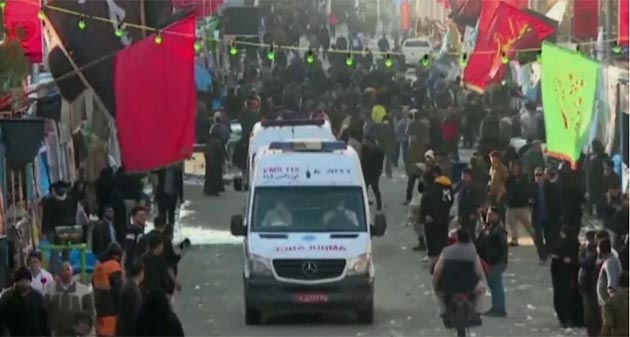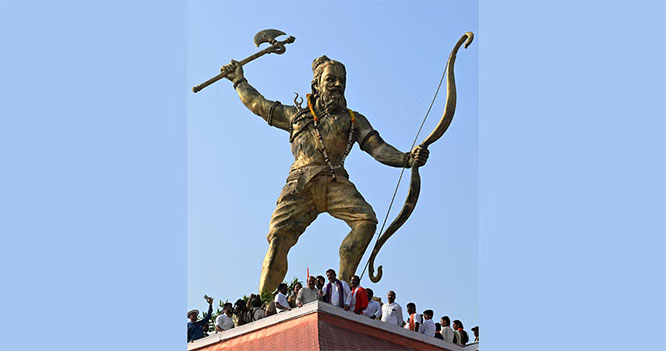
Hundreds of people have been killed and injured in two terrorist blasts near the burial site of Iran’s General Qassem Soleimani in the city of Kerman during a ceremony marking his fourth martyrdom anniversary.
The explosions on January 3 left 103 people dead and 211 more injured, state media reported.
Medical services said the death toll is expected to rise as ambulances were taking the wounded to hospitals, with Babak Yektaparast, deputy head of Iran's Emergency Organization, saying that some of the injured are in critical condition.
According to IRNA, the first explosion occurred some 700 meters from the grave of General Soleimani and the second one about one kilometer away.
Tasnim news agency cited unnamed sources as saying that two bags loaded with explosives which were remotely detonated caused the explosions. IRNA also quoted an informed source as saying two bombed bags detonated by remote control caused the explosions.
The first explosion occurred at 14:50 local time. The second one took place 10 minutes later, according to Kerman Mayor Saeed Tabrizi, ISNA reported.
Iran’s Red Crescent Society said three rescuers were killed by the second blast.
Some people were injured during a crowd crush following the first explosion. Officials say all the injured have been transferred to hospitals and the situation is under control.
There was no immediate claim of responsibility for the attack.
Meanwhile, the Iranian cabinet of ministers has announced a day of national mourning on Thursday.
Crushing response
Iran’s Interior Minister Ahmad Vahidi told the Islamic Republic of Iran’s News Network that a crushing response will soon be given to the culprits.
He said the bombing attacks were a continuation of various plots to kill innocent civilians at ceremonies across the country, many of which had been foiled by Iranian security services.
He said the situation is now under the control of security forces.
According to the minister, most of the fatalities were caused by the second blast. An investigation into the blasts has been launched and further details will be announced by officials as soon as possible, Vahidi noted.
Who is behind attacks?
Iran’s Judiciary Chief Gholam-Hossein Mohseni-Ejei vowed the perpetrators and those responsible for the attack will be swiftly hunted down and brought to justice.
Without directly mentioning the name of United States, he blamed the attacks on terrorists backed by the “world arrogance” who harbor deep grudges against General Soleimani, saying they’ve chosen to take revenge on the people after their various plots to insecure the country were foiled.
General Soleimani, commander of the Quds Force of Iran’s Islamic Revolution Guards Corps (IRGC), and Abu Mahdi al-Muhandis, the second-in-command of Iraq’s Popular Mobilization Units (PMU), and their companions were assassinated in a US drone strike authorized by then-US President Donald Trump near Baghdad International Airport on January 3, 2020.
Both commanders were highly revered across the Middle East because of their key role in fighting the Daesh Takfiri terrorist group in the region, particularly in Iraq and Syria.
In less than a week after the attack, Iraqi lawmakers approved a bill that required the government to expel all US-led foreign forces from the country.
The IRGC also targeted the US-run Ain al-Asad base in Iraq’s western province of Anbar with a wave of missile attacks in retaliation for the assassination of General Soleimani.
One of the worst in Iran
The Wednesday attack was one of the worst in Iran, which has seen similar attacks claimed by various terror groups, including Daesh and the Pakistan-based so-called Jaish al-Adl.
In September, Iranian media reports said a key Daesh-affiliated operative in charge of carrying out terrorist operations in Iran had been arrested in Kerman.
Back in July, Iran's intelligence ministry said it had disbanded a network that it said was linked to Israel's Mossad and which had been plotting terrorist operations across Iran, including in Kerman, according to IRNA.
IRNA said the alleged plots included "planning an explosion at the tomb" of General Soleimani as well as targeting other public gatherings.
In 2022, Daesh claimed responsibility for a deadly attack on a shrine in Iran’s city of Shiraz, which killed 15 people.
Earlier attacks claimed by the group include deadly twin bombings in 2017 which targeted Iran's parliament and the mausoleum of the late founder of the Islamic Republic Ayatollah Ruhollah Khomeini.
In 2019, a car bombing of an IRGC bus killed 27 troops in southeastern Iran. It was later claimed by Jaish al-Adl, a terror group formed in 2012.







Comments
Add new comment